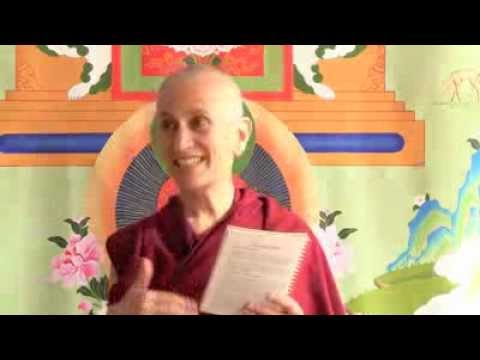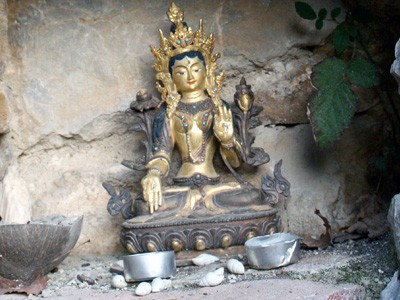Symbolism and visualization
This talk was given during the White Tara Winter Retreat at Sravasti Abbey.
- Understanding the symbolism of the visualization
- Buddhas manifest in physical forms in order to communicate with us
- Mantra and the energy of an enlightened mind
White Tara Retreat 38.1: Symbolism and visualization (download)
We’ve got a very interesting question here. Somebody’s saying, “Being a westerner, I find some of the Tibetan visualization and symbolism strange.” [Laughter] I think we all did at the beginning, didn’t we? “For example, when I visualize White Tara and the tam, etc., I find it difficult to connect this visualization with the goal of the practice. For example, if I would like to concentrate on achieving a clear mind, a more organic visualization such as clouds parting and revealing a clear blue sky feels like a more direct route for me. My question is: if I make stuff up, in a way, and create visualizations and practices for myself that seem to help me to understand and cultivate Buddhist philosophies and practices, am I in danger of straying off the path, so to speak?” Good question, isn’t it?
These visualizations were spoken by the Buddha manifesting in these different forms. They’re not visualizations and practices created by Joe Blow down the street who doesn’t know what he’s doing. They’re practices that were described by the Buddha and enlightened beings so I think we have to bear that in mind.
At first, the idea of clouds parting and a blue sky, I think you can do that. And when the clouds part, there’s Tara. Okay? The thing is we want to become Tara. When we’re visualizing Tara, we’re thinking of the Buddha that we want to become in the future. We’re thinking of what we want to be like and look like in the future when we’re fully enlightened. At first, the symbolisms and such about Tara, they may seem very strange to us. But when you understand what the symbolisms mean, and when you focus on them, you do get an idea of where that visualization is leading you. Okay?
We can’t communicate with the Buddha directly, mind to mind, because we can’t perceive the omniscient mind. So the Buddha manifests in physical forms that we can communicate with, and these physical forms represent different qualities. I think one of the big ones just to start with on a very gross level is the posture of Tara. When we’re sitting here like this [arms crossed in front of chest], it gives a certain energy, doesn’t it? When you’re sitting like this, like Tara’s sitting, it gives another energy because this [right] hand is reaching out to sentient beings to pull them out of cyclic existence. This [left] hand is the Three Jewels, and then these two fingers are wisdom and method, and showing perfect composure. The whole way she looks indicates some kind of peacefulness, some kind of clarity and purity—which is what we want to gain, not just physically but our mind. We want our mind to be pure and clear and reaching out to benefit sentient beings; and also holding the energy very carefully with refuge in the Three Jewels, and wisdom and method intact, and all of this. It gets us in touch with spiritual qualities through a symbolic means.
It appeals to the side of us that is artistic. That’s how artists and musicians and dancers communicate with us—is through the body and through sound. Similarly, with saying mantra, it isn’t like a TV commercial that somebody made up. It’s the sounds that a Buddha spoke when in deep meditation on the nature of reality. By reciting these same mantras, we get into that energy of what an enlightened mind focused on reality is all about.
Stay with the visualizations as they’re described. Don’t kind of put Tara in one of Michelle Obama’s fancy dresses, with Imelda Marcos’s shoes. [Laughter] Don’t do that. But think of what she’s communicating to us through her posture, through the sound of the mantra, and so on. If you want to have her like—you can see with the Medicine Buddha [indicating the thangka behind her], he’s actually up above the land in, well, there are clouds but these are clouds of offerings. So if you find it helpful to think of clouds parting and a clear open sky and Tara’s there, that’s fine. You can add something like that that helps your mind in that way but do stick to what an enlightened being did describe as the way to meditate.
Venerable Thubten Chodron
Venerable Chodron emphasizes the practical application of Buddha’s teachings in our daily lives and is especially skilled at explaining them in ways easily understood and practiced by Westerners. She is well known for her warm, humorous, and lucid teachings. She was ordained as a Buddhist nun in 1977 by Kyabje Ling Rinpoche in Dharamsala, India, and in 1986 she received bhikshuni (full) ordination in Taiwan. Read her full bio.


